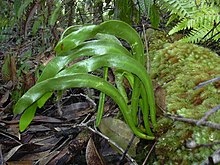Ophioderma (plant)
Appearance
| Ophioderma | |
|---|---|

| |
| Ophioderma pendulum | |
| Scientific classification | |
| Kingdom: | Plantae |
| Clade: | Tracheophytes |
| Division: | Polypodiophyta |
| Class: | Polypodiopsida |
| Order: | Ophioglossales |
| Family: | Ophioglossaceae |
| Subfamily: | Ophioglossoideae |
| Genus: | Ophioderma (Blume) Endl. |
| Type species | |
| Ophioderma pendulum (L.) Presl
| |
| Species | |
|
See text. | |
The genus Ophioderma are distinctive ferns (or fern-allies) in the family Ophioglossaceae. Ophioderma is closely related to, and sometimes treated as a subgenus of, the genus Ophioglossum. It includes the genus formerly known as Cheiroglossa. Recent genetic analysis has indicated that the two genera should be treated as one, and Ophioderma has precedence by being validly published at an earlier date. The type species is Ophioderma pendulum.
Phylogeny
[edit]| Ophioderma |
| ||||||||||||
Unassigned species:[3][note 1]
- Ophioderma intermedium (Hook.) Nishida
- Ophioderma simplex (Ridl. ex Bower) Nishida
- Ophioderma subsessile Amoroso & Coritico
Notes
[edit]References
[edit]- ^ Nitta, Joel H.; Schuettpelz, Eric; Ramírez-Barahona, Santiago; Iwasaki, Wataru; et al. (2022). "An Open and Continuously Updated Fern Tree of Life". Frontiers in Plant Science. 13: 909768. doi:10.3389/fpls.2022.909768. PMC 9449725. PMID 36092417.
- ^ "Tree viewer: interactive visualization of FTOL". FTOL v1.6.0 [GenBank release 259]. 2023. Retrieved 27 July 2024.
- ^ Hassler, Michael (2004–2021). "Genus Ophioderma (Blume) Endlicher". World Ferns. Synonymic Checklist and Distribution of Ferns and Lycophytes of the World. Version 12.8. Retrieved 2021-12-22.
- ^ Stearn, W.T. (2004), Botanical Latin (4th (p/b) ed.), Portland, Oregon: Timber Press, p. 398, ISBN 978-0-7153-1643-6
- Hauk, Warren D., Clifford R. Parks and Mark W. Chasel. "Phylogenetic studies of Ophioglossaceae: evidence from rbcL and trnL-F plastid DNA sequences and morphology." Molecular Phylogenetics and Evolution, 28(1): 131-141. 2003.
